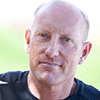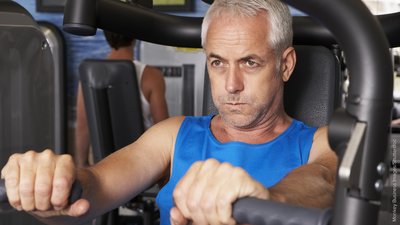As we get older, many of us view strength training as a young-person's game. There just seems like too much risk and not enough reward. Plus, nobody likes to start at the absolute bottom.
In terms of risk and reward, there's far more of the latter than the former. Building and maintaining muscle mass and strength is one of the absolute best things you can do to boost your quality of life at any age. It's no coincidence that studies have shown muscle mass to be a better predictor of lifespan than the ever-popular BMI.
As for the humiliation factor, being able to deal with that is what allowed me to get in my best-ever shape at age 55. Sure, it demanded humility, but that's not a bad thing. Luckily, for the most part, training for older athletes is largely the same as for their younger counterparts. In fact, the principles involved are exactly the same. The primary differences lie in the starting point and pace of progression.
But a handful of unique intangibles must also be addressed if you want to do this right, and do it for the long term. And to be clear, you should want both of those things!
1. Learn to Reconcile Needs with Wants
Many of us older lifters are still in decent or even great shape, at least in the context of the activities we love most. But we have a strong desire to be noteworthy. Actually, the word I typically use is "badass." Maybe the goal is a great physique, or to be very strong, or be highly ranked in some type of master's athletics. We want to stand out. We want to be great at something.
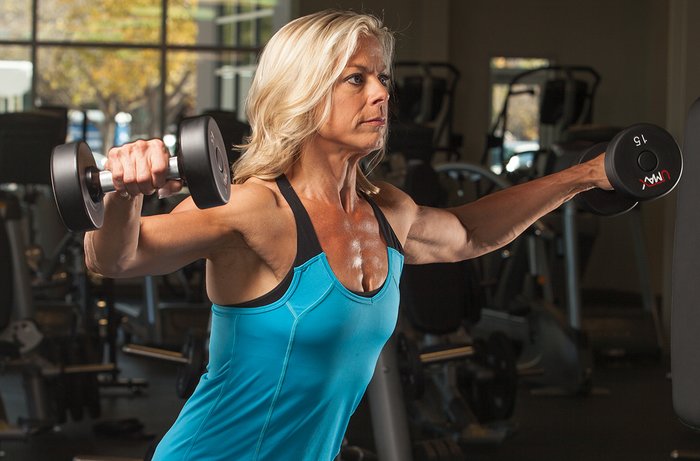
Make no mistake, the desire to be remarkable is completely healthy, and it can fuel you through those tough workouts. But the training it'll take for you to achieve your greatness doesn't always lead to the best possible health in later years. So if you want to be great and healthy, you'll need to reconcile these two somewhat conflicting goals.
One way to reconcile them is to engage in sports or activities that fit your body type and physical attributes. I've personally violated this recommendation in recent years, spending my 40s and 50s competing in weightlifting and powerlifting, neither of which is ideally suited to my 6-foot-1, 198-pound frame, and my relatively poor mobility.
I've been lucky so far, and reasonably successful, especially in powerlifting. But I'm always entertaining new possibilities to keep myself challenged and engaged with physical training. You should similarly keep an open mind.
2. Training Economy: Think Like an Accountant
I tell my clients, "Whenever you put your hands on a bar, there's always a cost. Whether or not there's a benefit is another matter."
When it comes to fitness—and this especially holds true as you get older—you always need to consider possible costs and benefits when planning your training activities. Costs are paid not just in time and energy, but often in injury risk, time away from other life pursuits, and orthopedic wear and tear years down the road.
Ideally, you want to purchase your gains at discount, not premium, prices. Here are just a few examples to stimulate your thinking:
- If you have low-back issues, front squat variations might be a "lower-cost" way to improve leg strength than barbell squats.
- Doing a relatively high number of reps with correspondingly lower weight might be a better way to gain muscle than doing lower reps with more weight. It's also usually more time-efficient, no matter what your orthopedic status might be.
- Seek to minimize waste in your workouts; put exercises for already well-developed muscle on the back burner. Don't rest 4 minutes between sets if you can do just as well with 3-minute rests. Focus your mobility efforts on your 1-2 tightest muscle groups. You get the idea.
- If you need better cardiorespiratory endurance and you weigh 250 pounds, maybe jogging isn't the best tool for the job. Opt for the bike or elliptical.
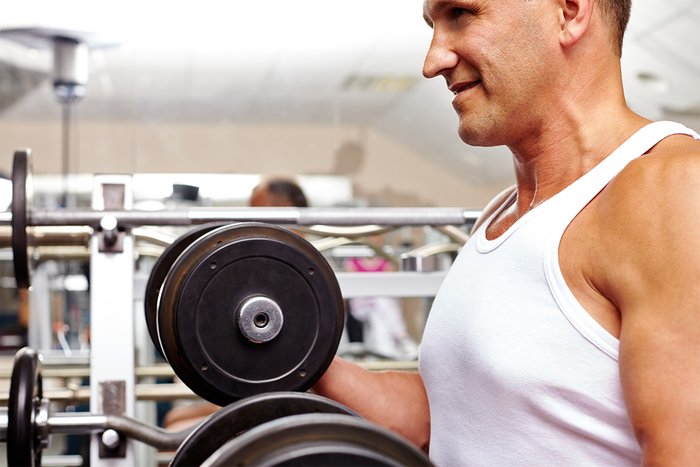
Mediaphotos/Shutterstock
The bottom line is that the older you get, the more training economy becomes a priority. Think in terms of Pareto principle: What are the 20 percent of inputs that can enable 80 percent of your outcomes? Identify and work hard on those things. When time and energy are limited, you'll know which things you can skip without significant consequence.
3. Identify and Shore Up Your Weakest Links
Fitness is composed of a variety of adaptations and capacities that all tend to decline with age and/or disuse, but at different rates. For example, it's relatively easy to maintain strength in later years, but the same can't always be said for mobility or power.
So here's a simple question to sharpen your focus on this topic: What could you do easily at age 18 that you can't do so easily today?
Running? Jumping? Throwing or catching a ball? Getting up off the floor? Touching your toes? Seeing your toes?
Whatever it is, your answer to this question is a glimpse into the physical capacities that have significantly declined for you over the years.
The various physical characteristics that comprise physical fitness are an interrelated web. The development of each quality affects the potential development of all the others. These capacities are like the strands of a spider web; you can't touch one without affecting the others.
4. Eat More Protein
As we age, the anabolic effects of training and nutrition become gradually less and less potent. So in order to stay in the game, you'll need to do more in order to get less. In particular, the effects of protein intake on muscle protein synthesis seem to dwindle in our later years. We also tend to tolerate carbohydrates a bit less effectively than we did when we were younger. These two conclusions argue for budgeting some of those carb calories toward protein.
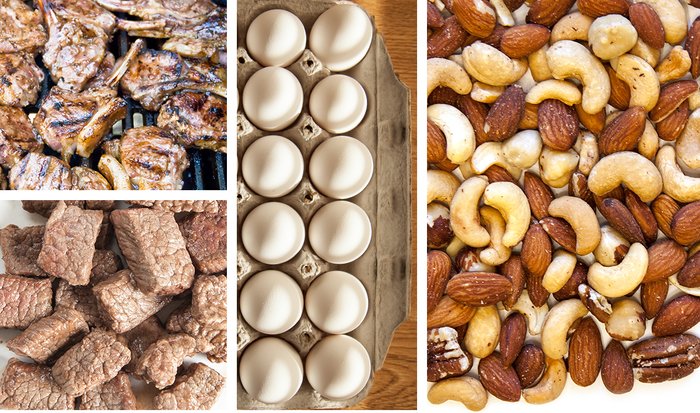
Dr. Layne Norton proposes the following recommended protein intake ranges for older athletes:
- < 18 years: 0.6-0.8 grams per pound of body weight
- 19-40 years: 0.8-1.1 grams per pound of body weight
- 41-65 years: 1.1-1.3 grams per pound of body weight
- 65 years: 1.3-1.5 grams per pound of body weight
Eating that much protein can seem like a chore, but supplementation helps a lot.
5. Don't Be Afraid to Be a Generalist
Ideally, very young athletes usually start out training in a very generalized manner. They might participate in soccer, swimming, gymnastics exercises, or track and field skills. You can envision this as the top or wide end of an hourglass.
Only later, in their mid to late teens, depending on the sport, do they begin to specialize to help them excel at their chosen sport. Think of this stage as the narrow "neck" of the hourglass.
As you move into your later years, I recommend shifting back to a more generalized training strategy. Imagine that you're 25 years old, and it takes you 20 minutes to "run" a mile. By any standard, that sucks, but the good news is that at age 25, it'll be pretty easy to fix. On the other hand, if you're 55, and it takes you 20 minutes, getting faster is going to be a battle. In fact, you may never re-establish a reasonable time.
The answer isn't to beat your head against what you can't do, but to search out what you can do. Regardless of your chosen athletic discipline, you should strive to improve at a broad range of fitness characteristics, even if they're not directly applicable to the sport or activity you love. The good news is that once a fitness trait has been established, it doesn't really take a lot of work to simply maintain it.
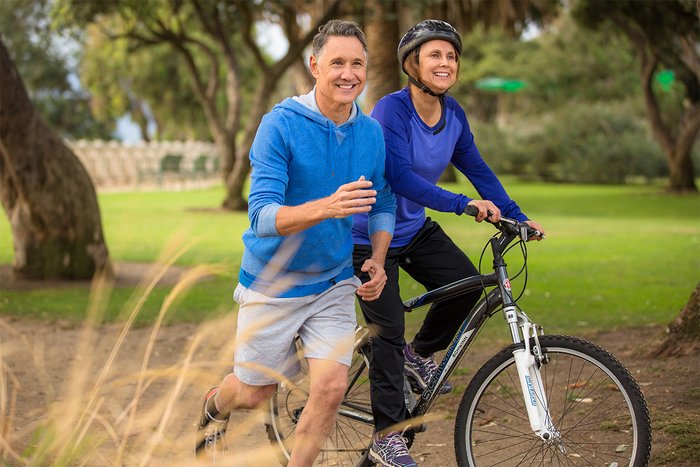
El Nariz/Shutterstock
Here's a practical suggestion to ensure that you maintain all-around fitness as you age: Find a measurable way to assess your current status for strength, cardiovascular ability, body composition, and mobility. You could do a lot worse than choosing the barbell deadlift, 1.5 mile run, a DEXA scan, and the Functional Movement Screen (FMS) for these four characteristics.
Next, "draw a line in the sand" for each: a level that is personally unacceptable for you. For me, a 500-pound deadlift for strength is one of my personal markers, but remember, I'm a competitive powerlifter. For you, it might be something totally different. Bodyweight for 5 reps can work, and once you hit that, then 1.5 bodyweight. Then double bodyweight. You get the idea.
There are no absolute rights and wrongs when it comes to this. The point is, define your personal standards for the fitness landmarks that matter to you, then get to work by attacking your weakest areas.
You Can't Cheat the System!
The older you get, the more that the "minor details" really matter: things like meal frequency, thorough warm-ups, adequate sleep, and stress management. You can definitely "cheat the system" on many of these items when you're younger, but you don't have that luxury later in life.
So, if you want to be a badass at 50, 60, or beyond, there's a price to pay in hard work and personal discipline. But the rewards are well worth it. The only downside? You can't let things drift away from you anymore like you could in your 20s. It's time to get to work!
For those who were once fit but have let things slide, Back to Fit is a straightforward, quality training program to change your ways back for good. If you've never been fit, you're never too old to start, and The Ultimate 30-Day Beginner's Guide to Fitness is your best bet for starting out right. In many cases, injury can be what stopped you from working out in the first place. If that's the case, Unstoppable will show you how to optimize your form, substitute the correct exercises for the ones giving you pain, and teach you how build a workout that works for you.
